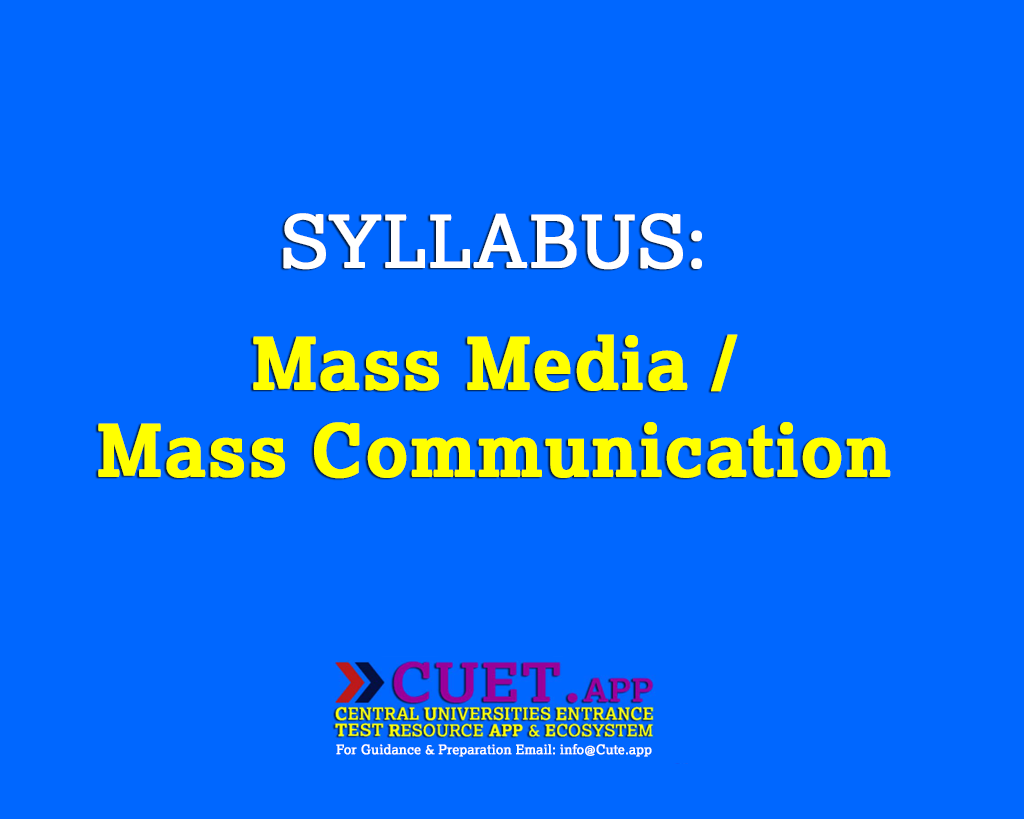Syllabus | Mass Media/ Mass Communication for Common University Entrance Test CUET (UG) – 2022
MASS MEDIA AND COMMUNICATION | SYLLABUS FOR CLASS 12
Note: There will be one Question Paper which will have 50 questions out of which 40 questions need to be attempted.
1.Communication
(i) Culture and Communication
What is culture? Relationship between culture and mass media; communication in the cultural context; media as vehicle of
cultural transmission; representation and stereotyping in Mass Media.
(ii) Communication and Social Change
Social change: meaning; media as a catalyst for social change (with examples of various social movements).
2. Journalism
(i) Qualities of a good Journalist.
An understanding of the following: nose for News, inquisitiveness, language skills, trustworthy and empathy.
(ii) Ethical Issues in Journalism.
A brief understanding of each of the following with examples: sensationalism, fake news, paid news, plagiarism, advertorials, partisan reporting and sting operations.
3. TV
A. Advertising
(i) Advertising concepts & process,
(ii) Functions of Advertising,
(iii) Types of Advertising (Cross promotions, Merchandise, Convert Advertising),
(iv) Forms of Advertising
B. Film
(i) Pre-Shooting stage.
(ii) Shooting Stage.
(iii) Post-Shooting Stage.
4. Radio
(i) Writing for Radio
Characteristics of a Radio Script: conversational language, active voice, simple sentences, avoidance of technical jargons and capability of creating imageries.
(ii) Recording Radio Programmes
Brief understanding of the radio studio and transmission equipment: types of microphones; amplifier, sound mixer, speakers; audio recording
(iii) Radio Jockeying
Role of a radio jockey; skills required: command on language (spoken and written), connectedness with the audience; knowledge about the recording equipment.
5. Cinema
(i) History of Cinema
A brief understanding of the early experiments done by the following: Lumiere Brothers, John Grierson, Robert Flaharty and Dada Saheb Phalke.
(ii) Cinema Genres.
Defining genre theory; an understanding of the various types of genres (with suitable examples): action, westerns, comedy, crime, drama, fantasy/sci-fi, historical, animation, romance and musical.
(iii) Cinema and Social Change.
Parallel Cinema movement in India: Issues depicted and low budget production process (with reference to examples such as Shyam Benegal’s Manthan).
6. Social Media
(i) Definition of social media.
(ii) Types of social media platforms.
Self-explanatory.
(iii) Role of social media in democracy.
Role of social media in creating collective identities with reference to sharing of information; cyber activism (with suitable examples)
(iv) Cyber Crime.
A understanding of online bullying; stalking; trolling; online frauds.
(v) Netiquettes.
Meaning and importance of netiquettes; an understanding of netiquettes such as: identification of oneself; respect for others’
privacy, use of appropriate language and imagery; do not spam.
7. New Media
(i) Internet as the meeting point of all the mass media.
(ii) Broadcasting
(iii) Mass communication model of a few transmitting to a vast number of receivers.
(iv) Gigantic organization.
(v) Huge technical infra-structure
(vi) Large scale revenue.
(vii) The changed paradigm due to the Internet.
(viii) Empowering an individual to post data on the Internet.
(ix) Information, message in one medium triggering off activity in the others.
(x) Many sources of the same information.
(xi) Distribution of the information between individuals on an unprecedented global scale.
(xii) Rapidity of opinion generation on a local, national and global scale.
(xiii) The socio-political implications of the new information order.
(xiv) The Strengthening of democracy.
(xv) Emerging trends in Mass Communication


